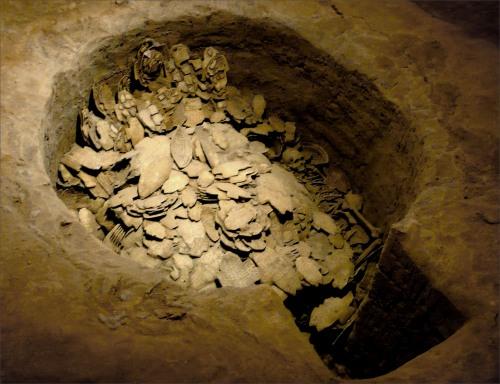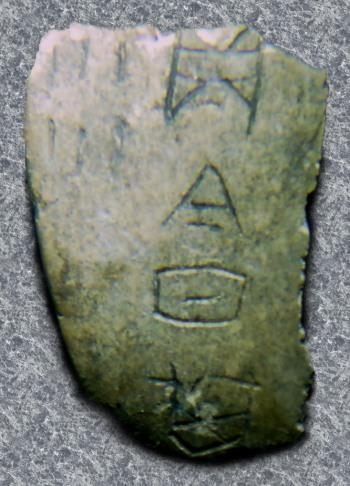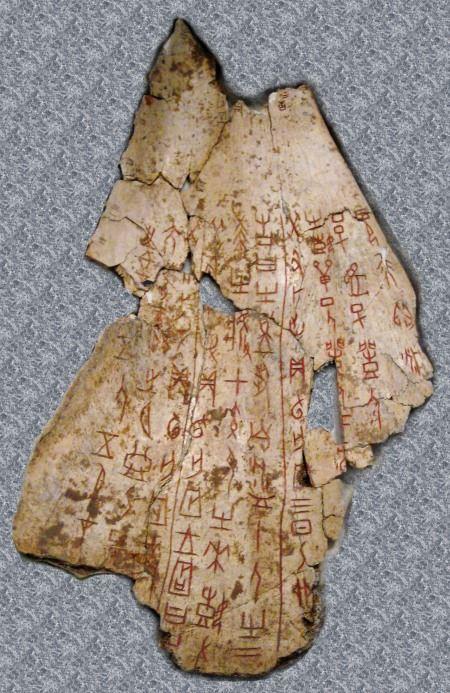Oracle bone script 甲骨文 Jiǎ gǔ wén ancient Chinese writing

One of the turning points in the appreciation of ancient Chinese culture came at the turn of the twentieth century. Up until then it was common for western scholars to consider that Chinese language and history was relatively late in development - that it really only got going in the Qin dynasty (221BCE) and so the Mediterranean and middle-eastern civilizations were older, some went so far as to suggest that Chinese civilization was an offshoot of a middle-eastern culture. The analysis of the Oracle bones in the 1920s changed all that. Not only had China an advanced written language stretching back nearly four thousand years but the early historical records that had been considered largely ‘legendary’ were shown to be surprisingly accurate.

Discovery of oracle bones
In 1899 Wáng Yìróng ➚ 王懿荣 noticed markings on bone fragments he had bought in a Beijing shop for grinding up to make a traditional medicine potion. These were called ‘dragon bones’ 龙骨 Lóng gǔ - like many other old bones and fossils to denote their antiquity and supposed medical efficacy. A collection of the diagrams of these marks was then published by the noted Chinese scholar and politician Wang Guowei ➚ 王国维 in 1903. This stimulated worldwide interest and many more bones and some bronzes came onto the market that had been dug up by the locals.
The source of the bones was traced to material washed into the 洹河 Huán hé river near the village of 小屯村 Xiǎo tún cūn, Anyang 安阳 ān yáng in Henan province. The villagers had stumbled upon the site of the city of Yin, the capital of Shang dynasty China (1711-1066BCE) (殷墟 Yīnxū).
In 1928 a full scale archaeological excavation under the auspices of the government 中国研究院历史语言研究所 Zhōng guó yán jiū yuàn lì shǐ yǔ yán yán jiū suǒ was initiated. In 1936 they found an undisturbed archive of 17,000 items including bones strung together into bundles. About 10% of all the bones are inscribed. In all over 100,000 inscribed bones have been unearthed and these became scattered worldwide for study, many of them have ended up in Taiwan after the Civil War. It seems that the Shang dynasty, fortunately for us, kept all the Imperial oracle bones as an archive. Bronzes, large qing musical stones, tombs and many other items were also found during the excavations. Although some of the bronzes had inscriptions they tend to be shorter in length and often used older script forms.
Oracle bone writing

Analysis showed that the inscriptions were associated with divination. The inscriptions on cattle bones and tortoise shells was identified as an early form of the written language used in the Chinese Bronze Age. The system of writing is called 甲骨文 Jiǎ gǔ wén (literally ‘first/shell bone writing’). It is the earliest form of writing known east of the Indus river. No earlier form of writing has been found in China mainly because these writings would have been made on perishable materials such as wood, bamboo and silk (bronze was only just coming into use).
How the bones were used for fortune telling
Only the King of the Shang people was permitted to make a divination, a scribe/diviner made the inscription and the ruler interpreted the result. The diviner made the inscription with a sharp instrument on a polished flat scapula or leg bone of cattle; some time later the underside of the tortoise shells were used as well. Tortoises were considered wise and venerable because there were known to live to a great age. The inscription was usually a short yes/no question with associated notes.
A row of small holes (凹穴 āo xué) was then made on the rough back surface; then a glowing hot bronze rod or wooden stick was placed against one of the holes causing the bone to crack with a loud popping noise.
The diviner (贞人 zhēn rén) then interpreted the pattern of cracks on the polished side. The heat usually produces two cracks roughly at right angles: one long crack along the grain of the bone and a shorter one across it. The modern character for divination 卜 bǔ is a picture of this crack pattern. The answer was auspicious if the cracks matched this pattern - one main crack with a smaller spur at an angle. The verdict on the analysis of the cracks were recorded on the bone as either auspicious 吉 jí or inauspicious 凶 xiōng. The ruler provided the interpretation and this was usually then inscribed on the bone next to the question. Different areas of the same bone were often used for further inscriptions .
Questions asked
The inscriptions consisted of a standard set of parts but were not always complete: a preface (giving the date and the diviner); a charge (the question being asked); a prognostication (interpretation of the answer) and finally a verification (what actually happened - was the divination accurate?). This standard structure have greatly aided the interpretation of the inscriptions. About 120 individual diviners have been identified which has enabled the inscriptions to be put into historical order. Sometimes, especially when concerning royal births the king himself made the divination. Some rulers used the divination method more frequently than others - the penultimate Shang ruler Wu Ding ➚ was the most prolific diviner so most date to around 1100BCE. If an unfavorable response was received, then after appeasing the gods - sometimes with human sacrifices - the same question was repeated in the hope they would get a different answer. It seems that divinations were never challenged as 'incorrect', perhaps the ruler either repeated the divination until it came out to match the actual outcome or the offending bones were quietly destroyed - such bones would have shown the system as fallible.

Most inscriptions are of about a dozen characters but some have up to sixty. They were written in columns top to bottom but sometimes left to right rather than the traditional Chinese right to left depending on the direction of the crack.
There was a wide range of different subjects for divine inquiry include checking whether sacrifices were acceptable, informing the ancestors of family events, predicting rainfall, curing illness, seeking fortune in hunting, war, and the wisdom of embarking on journeys. Many refer to the supreme god of the Shang as 帝 Dì. From the inscriptions the history of the Shang dynasty and the everyday life of rulers have been reconstructed.
Example oracle bones
Here are some examples of the inscriptions (giving only the question part):
‘Dun will have a sickness/ Dun will not have a sickness.’‘There is a sick tooth; is it not father Yi who is causing it.’ (Yi was the Shang ruler Wǔ Dīng ➚’s 武丁 dead father, ancestors were believed to influence the life of the living - including giving them toothache)
‘This rain will be disastrous to us/ This rain will not be disastrous to us.’
‘If we build a settlement, Di will not obstruct, not approve.’
‘It should be Lady Hao whom the king orders to campaign against Yi.’ (The famous Lady Hao ➚’s tomb has been found intact and excavated. She was a high ranking Shang general.)
‘Di approves the king/ Di does not approve the king.’
‘In the ten days there will be no disasters.’ answer ‘the King read the cracks and said “auspicious”.’
The oracle bone method of divination seems to have died out with the Shang dynasty. The succeeding Zhou dynasty used the simpler and quicker Yi Jing (I Ching) method.
Ancient Characters
Of the 4,500 different characters used on the oracle bones, about 2,000 have been mapped to modern equivalents; others include personal and place names and so are pretty impossible to translate. The recognizable marks are mainly pictorial characters which still somewhat resemble current forms. Although they form a small proportion of the total number of modern characters in use they are the ones most frequently used, including ‘big’, ‘man’, ‘sun’ and ‘moon’. Sometimes the characters were inscribed as a mirror image - for example 明 ‘bright’ was written as sun (right) - moon (left) pair as well as sun (left) - moon (right).
The ancient script had already started simplifying the characters, this was proven by the discovery of older characters on bronzes produced at the same time that are more life-like representation of physical objects. This strongly suggests that the script had been in use for hundreds of years and it had become convenient to simplify the marks and so the oracle bone script was not the first written language.
Writing was also made on strips of silk, bamboo and wood but as these have not survived it is the oracle bones that receive all the acclaim. A modern character for book: 册 cè (traditional form 冊) is identifiable from this source - it depicts bamboo strips tied together by two cords at top and bottom.

Advanced Civilization
The Chinese character for civilization 文化 wén huà is literally ‘writing transformation’ showing that writing was considered the cornerstone of civilization as people became transformed by the influence of writing.
Study of the inscriptions had revealed early, astronomical study of the stars as individual stars and constellations are named. The inscriptions include the oldest observation of a nova (1300BCE) ‘A great new star appeared in company with 心宿二 Xīn xiù èr (Antares, in Scorpio)’ is recorded on the bones. The traditional sexagesimal 六十花甲 liù shí huā jiǎ Chinese system for numbering days and years was used and the traditional Chinese calendar system with its twelve 30 or 29 day months and an occasional leap month was already well established. A ten day week was in operation so that three weeks conveniently fit into a month.
Characters also demonstrate that accurate solar observations were being made with characters representing the solstices and eclipses. The form of the character for late afternoon is depicted with the shadow of the sun and moon and the character for ‘eclipse’ 食 shí depicts a dragon devouring the sun or moon.
Advanced observations were also made of the planets. The system of Twelve Earthly branches that are the basis for Chinese astrology have there origin at least as far back as the Shang. The 12 branches are believed to come from studies of the orbit of the planet Jupiter (木星) that takes roughly 12 years (actually 11.86) to orbit the sun, and so observation of the planet's position gives the year in the sequence. One name for Jupiter is ‘year star’ 岁星 suì xīng which confirms the association.
Verifying Chinese history
As well as proving that an advanced, literate civilization existed in China as far back as the Shang dynasty the finds show that the historical documents that had been dismissed as legends were firmly based in reality. In particular the 史记 Shǐ jì ‘Records of the Grand Historian’ by Sima Qian proved remarkably accurate. Sima Qian had recorded that the city of Yin was located on the river Huan which proved correct and his list of 30 Shang rulers in the 殷本纪 Yīn běn jì was confirmed by the discoveries - impressive considering he wrote it one thousand years after the events. This suggests books of record were written but then lost to decay in the intervening period. Some of the names had become corrupted over the centuries but 25 proved correct. Part of the kings’ names was the ‘ordinal number’ as defined in the ten heavenly stems. For example for 武丁 Wǔ dīng the ‘dīng’ puts him as the 4th Shang King in the sequence, ‘Wu’ was his personal name.
Early dictionaries were also shown to be accurate, in particular the 说文解字 Shuō wén jiě zì composed by 许慎 Xǔ shèn [25-220CE] who completed it about 100CE. It cross-referenced several early scripts including the ‘jiaguwen’ oracle bone script.
Oracle bone characters
Here are some individual characters showing how the Shang dynasty character forms used on the oracle bones have evolved over three thousand years.

'Eye' in oracle bone script. Available under a Creative Commons License ➚

'Dog' in oracle bone script. Available under a Creative Commons License ➚

'Tortoise' in oracle bone script. Image by The New Mikemoral ➚ available under a Creative Commons License ➚

'Woman' in oracle bone script. Image by Bookworm8899 available under a Creative Commons License ➚

'Mother' in oracle bone script. Image by Bookworm8899 available under a Creative Commons License ➚

'Below; down' in oracle bone script. . Image by HenryLi ➚ available under a Creative Commons License ➚

'Up; above; on' in oracle bone script. Image by HenryLi ➚ available under a Creative Commons License ➚